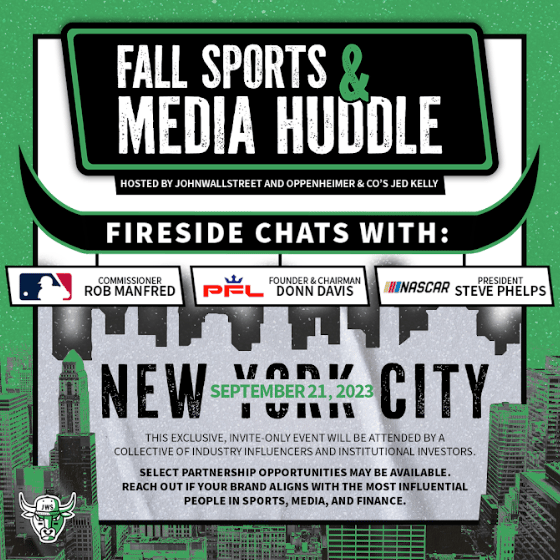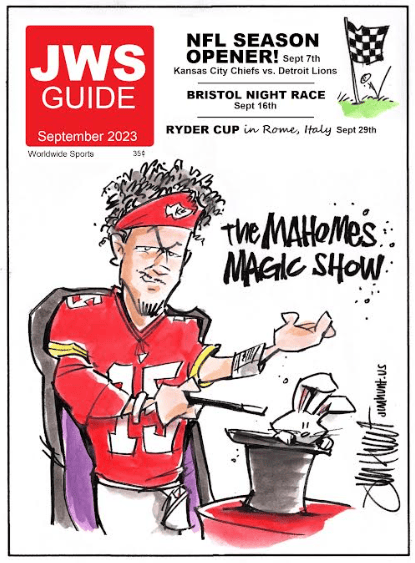- JohnWallStreet
- Posts
- MLB Virtual Ballpark Seeks to Make Broadcast a ‘Lean Forward Experience’
MLB Virtual Ballpark Seeks to Make Broadcast a ‘Lean Forward Experience’

Editor’s Note: Adam Grossman is at the controls again this morning. You will find his latest Revenue Above Replacement column below. I’ll be back tomorrow.
MLB Virtual Ballpark Seeks to Make Broadcast a ‘Lean Forward Experience’

Rule changes and investments in technological innovation have helped Major League Baseball (MLB) teams drive substantial attendance gains this season.
But catching a game in person is not something that many fans can do easily or consistently.
The desire to deliver the interactive in-person experience to a broader audience was among the catalysts for MLB to construct a three-dimensional (3D) virtual ballpark. Tonight’s game between the Los Angeles Angels and Tampa Bay Rays will be the first regular season contest streamed inside the venue.
Fifteen thousand fans from across the globe will be able to access the event. All they’ll need is an internet connected device to do so (i.e., no subscriptions to Pay TV or MLB.TV are necessary).
Participants will be able to see a 3D representation of the game from previously unseen angles, communicate with other fans inside the stadium, explore the virtual venue–and watch the traditional broadcast on digital videoboards via MLB’s Gameday 3D technology.
MLB partnered with Improbable to build the virtual platform. The London-based tech company creates digital spaces for brands to connect with their customers. MLB first encountered Improbable leveraging non-fungible tokens (NFTs) to increase audience engagement back in 2020.
Every established sports property is trying to attract younger demographics and grow their fanbase.
MLB has made engaging Gen-Zs a strategic priority given that its audience –at least the portion that watches games on television– tends to skew older. A 2017 Nielsen study found the median age of MLB viewers is 57 years old.
SPONSORED BY VISION INSIGHTS
Playfly Sports has released brand new MLB insights in its new report: Playfly Fan Score: MLB Edition powered by Vision Insights.
For example, Playfly has identified a new type of super fan called the Forever Fan. These fans have been fans since childhood and consider their favorite team to be a part of their identity. They are three times more likely to emotionally connect with their team’s sponsors, visit those advertisers’ apps or websites, and make a purchase from a brand aligned with their favorite team. Major League Baseball has the highest concentration of Forever Fans out of any of the four major sports leagues.

Playfly Fan Score also ranks teams based on 12 proprietary algorithms developed by the internal team of data scientists and the team at Vision Insights. All leading to a fresh perspective to understanding fandom including: Fan Passion, Fan Receptivity, Fan Marketplace.
Playfly Sports Consulting can help you with your team or brand needs.
Over the last six years, the league has made substantial headway on this initiative; in large part by reaching younger audiences on digital channels. It is increasingly finding fans consuming games on MLB.TV and content, like MLB Originals and Celebrity Sluggers, on YouTube.
Younger audiences are using platforms, like Roblox, as immersive and interactive 3D digital playgrounds too. Roblox garners 65.5 million daily active users worldwide. The vast majority of those individuals are under the age of 25.
So, it made sense for MLB to create its own virtual environment, one that includes spatial audio, trivia games, and scavenger hunts.
“Our hope is that [the virtual ballpark] appeals to a youth audience, but not exclusively to a youth audience,” Kenny Gersh (EVP, media and business development, MLB) said. “The social aspects reach a broad, digitally savvy audience that tends to skew younger.”
Content personalization is another key feature within these virtual universes. Users can alter their experience to their individual gaming tastes.
MLB’s virtual ballpark was designed with that kind of functionality in mind.
“You can [view] the game from all different angles and perspectives,” Gersh said. “In a live broadcast that would not always be possible because we don’t have all the cameras.”
There is optimism amongst sports industry executives that a personalized experience can lead to increased audience engagement when combined with interactive elements. Concerns currently exist that sports fans, particularly younger ones, are spending too much time looking at their second screen when the game is taking place.
“Our goal is to make the first screen more entertaining and retain [the viewer’s attention] on that one screen [rather] than dividing into two,” Gersh said. “It is to make the broadcast a lean forward experience where [the fan is] engaged with content as opposed to leaning back looking at something else to do at the same time.”
Of course, fans often need a second screen to engage with others during a sporting event because of the limitations that exist on linear broadcast technology.
Interpersonal communication is not an issue on Roblox. The interactive component is native to the platform and experience. Gamers navigate a shared environment and can engage with other competitors from around the world on a single screen.
MLB’s virtual ballpark has a chat feature that uses spatial audio enabling fans to do the same. Angels fans in Japan and Los Angeles, along with Rays fans in Tampa and Mexico, can all watch the game together in the same place and interact with each other for the first time.
It is important to note that MLB does not see its virtual ballpark as a replacement for the traditional game broadcast. The 3D experience is intended to augment over-the-air, pay television, or direct to consumer carriage.
And the league sees use cases for the technology beyond streaming regular season games. MLB conducted its first test during the 2023 All-Star Celebrity Softball Game and believes there may be an opportunity to deliver 3D virtualizations of other events held at MLB stadiums (think: concerts).
“MLB’s history is to push the envelope in technology,” Gersh said. “We are focused on staying at the cutting edge of technology. [Digital playgrounds are] the next evolution of the approach.”
Fans who grew up watching one digital pitch placement at a time come through the old Gameday site, which launched in the 2000s, will appreciate how far the technology has come.


Top 5 Sports Business Headlines
Click here to subscribe to Sport & Story Daily and never miss a story.
🚨 Max gets bigger with Bleacher Report sports tier
🤝🏼 XFL, USFL nearing agreement to merge operations
📺 Monday Night Football averages 21.8 million viewers across ESPN platforms
🏈 FOX Sports blooms with nailbiters
⚾ Rays lock in a long-term home with new stadium deal

About The Author: Adam Grossman is the Vice President of Business Insights & Analytics at Excel Sports Management. He works with companies, sports properties, media rights holders, athletes, agencies, and events to determine the value of their most important assets. Grossman is also a professor at Northwestern University Master’s In Sports Administration program and the co-author of The Sports Strategist: Developing Leaders for a High-Performance Industry. You can find him at [email protected].

